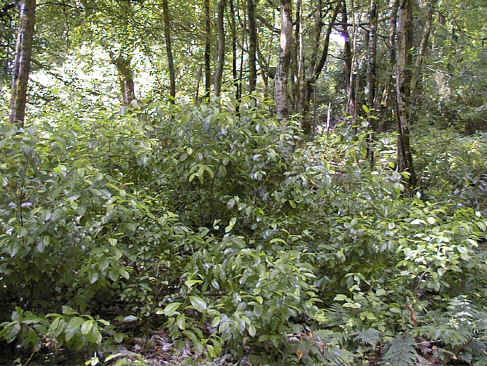The Wet Woodland Plant Survey
General Introduction
continued
Area Description The Wet Woodland consists of 6 visibly distinct areas, one of which is a central, shallow boggy depression with a small amount of standing water. This is known as the Seepage Area. Adjacent to and surrounding this, are five areas with varying degrees of moisture in the soil. The Bluebell, Cherry and Stony Areas are at the top of the slope and are consequently the driest of the areas. The Bluebell Area has thicker soil while the Stony Area and the Cherry Area have shallower soils with lots of lose flints on the surface. Further down the slope and on either side of the Seepage Area are The Mound and The Clearance. The Mound is a small rounded hillock that has fairly steep sides and dry soil due to its height above the rest of the Wet Woodland. The Clearance is near the bottom of the overall slope of the Wet Woodland and is the next most damp area after the Seepage. As with the Seepage, it has thicker soil that is partly waterlogged in places, particularly where it joins with the Seepage. There are tall broad-leaved trees throughout the Wet Woodland, but these trees are fewer in the Stony and Clearance areas where more sunlight reaches the ground. As for ground level plants, the Cherry Area is dominated by a species of non-native cherry which is fast growing and grows in dense patches, blocking sunlight from reaching the ground and preventing many other plants from being able to grow. The Bluebell Area is more typical of broad-leaved English woodland with a thick carpet of colourful bluebells during the spring. At other times of the year, this area is dominated by a variety of ferns and mosses at ground level. At first sight, the Stony Area appears relatively bare, with just a few ferns, grasses and herbaceous plants. However, a closer inspection reveals a comparatively high number of different species of moss, albeit in small quantities. The Clearance has large "carpets" of a moss called Polytrichum formosum. Being fairly damp and adjacent to the Seepage area, many species which grow there are also present in the Clearance. Some of the plants which grow in the Seepage area are found nowhere else in the Wet Woodland. This is mainly due to the fact that they are moisture loving species such as sedges, rushes and sphagnum mosses. The Mound is one of the driest areas of the Wet Woodland and supports significant amounts of Sheep's Fescue grass (Festuca ovina) along with very young holly trees, bramble, mosses and Rhododendron ponticum. What is The Wet Woodland Project? The Wet Woodland Project is part of a larger project called "The Northern Study Area Wetland Project". The Wet Woodland Plant Survey is funded by Heritage Lottery and the Nationwide Building Society through the Local Heritage Initiative (LHI) which is administered by the Countryside Agency. The project is also funded by the Pennon Water Champions Fund through the Landfill Tax Credit Scheme. The project involves three sections. 1) Initial ecological survey of plant species present in The Wet Woodland. This is known as the Wet Woodland Plant Survey and is the subject matter of the following web pages. 2) The Wet
Woodland Bird Survey. This survey was carried out to establish any link between
the species of birds present and the differences in habitat across the six distinct areas
within the Wet Woodland. Why is the project being carried out? There are two main reasons for carrying out the Wet Woodland Project. 1) Some Rhododendron clearance has taken place since 1986 but the species remains a problem in the Wet Woodland Area and requires continuing control to prevent it from engulfing the area. The Wet Woodland Plant Survey Initial survey will establish how diverse the native plant species are. 2) Inspections of The Wet Woodland during early summer 2001 have revealed that a species of non-native cherry has spread significantly throughout the area. Left unchecked, this species represents a real threat to the continued diversity of native plants. This is because it is fast growing and stops light from reaching the ground, thus preventing young plants of other species from growing. The initial survey will reveal the extent of the problem, while practical work to remove the alien cherry and rhododendron plants will help maintain native plant diversity. Future Objective As a result of producing this initial survey, a need was established to conduct a concluding botanical survey following practical work. The Concluding survey would establish the effect of practical work on plant diversity in the Wet Woodland Area. The survey will be conducted when suitable funding becomes available.
The initial ecological survey of The Wet Woodland was carried out in early summer 2001 with an aim of establishing the plant diversity in each of the six separate areas. The survey also set out to demonstrate the threat to native species from the non-native cherry and Rhododendron ponticum. Following the initial survey, practical work would commence to remove the alien species and encourage the natural establishment of native plants. |
Continue to Summary of Wet Woodland Survey
